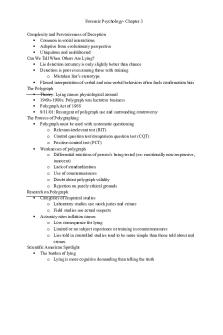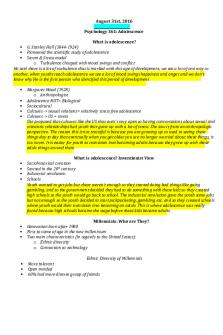Psychology Chapter 3 Notes PDF

| Title | Psychology Chapter 3 Notes |
|---|---|
| Course | Introduction to Psychology |
| Institution | The University of Texas at San Antonio |
| Pages | 4 |
| File Size | 62.1 KB |
| File Type | |
| Total Downloads | 46 |
| Total Views | 205 |
Summary
Chapter 3 notes. Professor Sameul Van Buskirk...
Description
Psychology Chapter 3 Biological psychology: Nerve cells
Neurons o Never cells specialized for communication with each other 85 million neurons, 160 trillion connections between them Parts of a neuron o Cell body (soma) Center of neuron, builds new cell components o Dendrites Branch-like extensions for receiving information from other neurons o Axon Portion of neuron that sends signals Synaptic vesicle Spherical sac containing neurotransmitters Neurotransmitters Chemical messengers specialized for communication from neuron to neuron o Synapses Tiny fluid filled spaces between neurons through which neurotransmitters travels Synaptic clef A gap into which neurotransmitters are released from the axon terminal
Glial cells
Play roll in the formation of myelin and the blood-brain barrier, responds to injury, removes debris, and enhances learning and memory Types of Glial cells o Astrocytes- most abundant, increase accuracy of transmission, help control blood flow in the brain, plays vital role in the development of the embryo, memory, thought, and the immune system. o Oligodendrocytes- promote connections and produce the myelin sheath
Electrifying thought
Neurons respond to neurotransmitters by generating electrical activity Resting potential o Electrical charge difference (-60 millivolts) across the neuronal membrane, when the neuron is not being stimulated or inhibited Threshold o Membrane potential necessary to trigger an action potential
Action Potentials
Action potential
o
Electrical impulse that travels down the axon triggering the release of neurotransmitters
The absolute refractory period
Neurons can fire 100-1000 times per second When released, the neurotransmitters bind with the next neurons receptor site Absolute refractory periodo Time during which another action potential is impossible; limits firing rate
Chemical communication: Neurotransmission
This process is halted by reuptake, when neurotransmitters go back into the axon terminal Some neurotransmitters excited and some inhibit Glutamate and GABA are the most common neurotransmitters in the central nervous system Glutamate is excitatory, GABA is inhibiting Acetocholine influences arousal, selective attention, sleep, and memory Monoamines contain only one amino acid o Norepinephrine and serotonin influence arousal o Dopamine plays a role in our response to rewarding experiences Neuropeptides have specialized functions (like endorphins for pain relief) Anandamines bind to the same receptors as THC and influence eating, motivation, memory, and sleep
Psychoactive drugs
Psychoactive drugs impact mood, arousal, or behavior by acting as agonists or antagonists for neurotransmitters Agonists- Increase neurotransmitter activity Antagonists- Decrease neurotransmitter activity
Agonists and Antagonists
Agonists o Opiods- mimic endorphins o Alcohol, Xanax- stimulate GABA receptors o Prozac, Paxil- block serotonin reuptake Antagonists o Antipsychotics- block dopamine from receptors o Botox- blocks Acetocholine
Neural plasticity
Plasticity- nervous system’s ability to change over time Neurons change in four ways during development 1. Growth of dendrites and axons 2. Synaptogenesis 3. Pruning 4. Myelination
During learning, long-term potentiation occurs and makes synapses perform better There is only limited recovery following brain injury or serious illness Stem cell therapies may someday encourage plasticity after injury or degeneration Neurogenesis- creation of new neurons- does not occur during adulthood
The brain-behavior network
Sensory information comes into-and decisions come out of- the central nervous system (CNS) The nerves outside the CNS are called the peripheral nervous system (PNS)
The central nervous system
The CNS is divided into distinct systems based on located and function
Cerebral cortex
The forebrain is the most developed area of the human brain, giving us our advanced intellectual abilities Consists of two cerebral hemispheres connected by the corpus callosum which allows communication between them The majority of the forebrain is composed of the cerebral cortex It can be divided into four lobes, each associated with a different function
Frontal Lobe
Oversee and organize most other brain functions (executive functioning) The body is mapped onto the motor cortex The prefrontal cortex is responsible for thinking, planning, and language o Broca’s area important for speech comprehension
Parietal lobe
Contains the somatosensory cortex, which is sensitive to touch, pain, and temperature Helps track objects locations in space Communicates information to the motor cortex every time we reach, grasp, or move our eyes
Temporal lobe
The lower part of the cerebral cortex, it plays a role in hearing, understanding language, and storing autobiographical memories Contains the auditory cortex and Wernicke’s area responsible for speech comprehension
Occipital lobe
Lies at the rear of the brain and is specialized for vision When sensory information enters the brain, it first goes to that sense’s primary sensory cortex, then to the associated cortex
Basil Ganglia
Forebrain structure that helps control movement
Allows us to perform movements to obtain rewards and reinforcement Damage can contribute to Parkinson’s disease
Limbic system
The emotional center of the brain that also has a role in smell, motivation, and memory Thalamus relays information from the sensory organs to the primary sensory cortex Hypothalamus regulates and controls internal body stats; controls the pituitary gland Amygdala plays key roles in fear, excitement, and arousal Hippocampus plays a role in spatial memory; damage causes inability to form new memories
Brain stem
Connects the cerebral cortex and spinal cord Performs some basic bodily functions Serves as a relay station between the cortex and the rest of the nervous system Midbrain contributes to movement, tracking of visual stimuli, and reflexes triggered by sound Reticular activating system connects the forebrain and cerebral cortex and plays key role in arousal
Hindbrain
Cerebellum plays a predominant role in our sense of balance and enables us to coordinate movement and learn motor skills Pons connects cortex to cerebellum and triggers dreams Medulla regulates breathing, heartbeat, and other vital functions
Spinal cord
Thick bundle of nerves that conveys signals between the brain and the body Sensory nerves carry information from the body to the brain; motor nerves carry information from brain to the rest of the body Also contains interneurons, which allow reflexes to happen
Peripheral nervous system
Somatic nervous system conveys information between the CNS and the body, controlling and coordinating voluntary movement Autonomic nervous system controls the involuntary actions, internal organs, and glands o Has two divisions, sympathetic and parasympathetic...
Similar Free PDFs

Psychology Chapter 3 Notes
- 4 Pages

Psychology Notes- chapter 3
- 3 Pages

Forensic Psychology Chapter 3
- 3 Pages

Chapter 3 Psychology
- 8 Pages

Abnormal Psychology Chapter 3
- 9 Pages

Psychology Chapter 9 Notes
- 14 Pages

Psychology Chapter 4 Notes
- 6 Pages

Psychology notes - chapter 1
- 2 Pages

Psychology Chapter 8 Notes
- 6 Pages

Chapter 16 Psychology Notes
- 18 Pages

Psychology Chapter 2 Notes
- 8 Pages

Psychology 361 Notes 1-3
- 19 Pages

Psychology UNIT 3/4 Notes
- 115 Pages
Popular Institutions
- Tinajero National High School - Annex
- Politeknik Caltex Riau
- Yokohama City University
- SGT University
- University of Al-Qadisiyah
- Divine Word College of Vigan
- Techniek College Rotterdam
- Universidade de Santiago
- Universiti Teknologi MARA Cawangan Johor Kampus Pasir Gudang
- Poltekkes Kemenkes Yogyakarta
- Baguio City National High School
- Colegio san marcos
- preparatoria uno
- Centro de Bachillerato Tecnológico Industrial y de Servicios No. 107
- Dalian Maritime University
- Quang Trung Secondary School
- Colegio Tecnológico en Informática
- Corporación Regional de Educación Superior
- Grupo CEDVA
- Dar Al Uloom University
- Centro de Estudios Preuniversitarios de la Universidad Nacional de Ingeniería
- 上智大学
- Aakash International School, Nuna Majara
- San Felipe Neri Catholic School
- Kang Chiao International School - New Taipei City
- Misamis Occidental National High School
- Institución Educativa Escuela Normal Juan Ladrilleros
- Kolehiyo ng Pantukan
- Batanes State College
- Instituto Continental
- Sekolah Menengah Kejuruan Kesehatan Kaltara (Tarakan)
- Colegio de La Inmaculada Concepcion - Cebu


